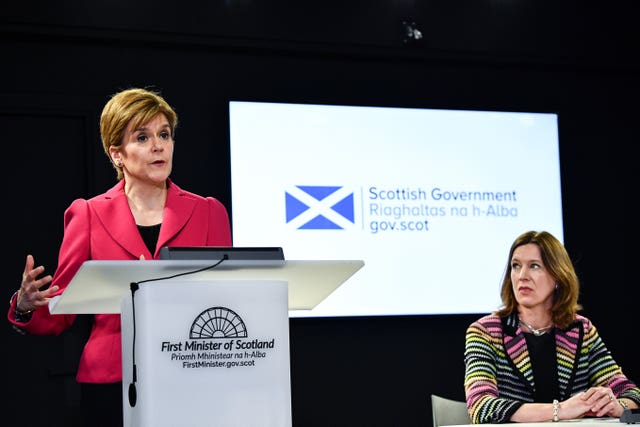Doctor Catherine Calderwood spent half a decade influencing policy and practise in the top medical job in Scotland before her resignation in disgrace.
Her appointment as chief medical officer for Scotland came after more than two decades of work in the health service, including on the investigation into the deaths of mothers and newborn babies at Morecombe Bay.
READ MORE: Coronavirus: CMO Dr Catherine Calderwood resigns
Born in 1968, Dr Calderwood completed her undergraduate studies at Cambridge University, before qualifying as a medic from the University of Glasgow in 1993.
She worked as a junior doctor in Glasgow Royal Infirmary and the Royal Infirmary of Edinburgh before specialising in obstetrics and gynaecology.
 Scotland’s First Minister Nicola Sturgeon said Chief Medical Officer Dr Catherine Calderwood had completed ‘transformational’ work in the role (Jeff J Mitchell/PA)
Scotland’s First Minister Nicola Sturgeon said Chief Medical Officer Dr Catherine Calderwood had completed ‘transformational’ work in the role (Jeff J Mitchell/PA)
This knowledge was key to her involvement in helping to reduce stillbirths and neonatal deaths in Scotland since becoming an adviser to the government in 2010.
After taking on the role of chief medical officer in 2015, Dr Calderwood, 51, continued to have a maternity medicine and antenatal clinic at the Royal Infirmary of Edinburgh.
READ MORE: Coronavirus: CMO Catherine Calderwood removed from public-facing role
She chairs the UK maternal, newborn and infant clinical outcome review programme and the Scottish Government stillbirth working group and is also a member of Royal College of Obstetricians and Gynaecologists stillbirth clinical studies group.
However, the doctor’s position as chief medical officer was considered untenable after she was photographed at her second home, in contravention of coronavirus lockdown rules.
Despite apologising after the pictures of her family hear her Fife home appeared in the Sun on Sunday, Dr Calderwood resigned “with a heavy heart”.
After she stepped down on Sunday evening, First Minister Nicola Sturgeon paid tribute to Dr Calderwood and her “transformational” work.
She said: “While she has made a very serious mistake in her actions, that should not detract from the fact that as CMO she has made a highly valuable contribution to the medical profession and to health in Scotland, and I have no doubt she will continue to do so in future.”


Why are you making commenting on The Herald only available to subscribers?
It should have been a safe space for informed debate, somewhere for readers to discuss issues around the biggest stories of the day, but all too often the below the line comments on most websites have become bogged down by off-topic discussions and abuse.
heraldscotland.com is tackling this problem by allowing only subscribers to comment.
We are doing this to improve the experience for our loyal readers and we believe it will reduce the ability of trolls and troublemakers, who occasionally find their way onto our site, to abuse our journalists and readers. We also hope it will help the comments section fulfil its promise as a part of Scotland's conversation with itself.
We are lucky at The Herald. We are read by an informed, educated readership who can add their knowledge and insights to our stories.
That is invaluable.
We are making the subscriber-only change to support our valued readers, who tell us they don't want the site cluttered up with irrelevant comments, untruths and abuse.
In the past, the journalist’s job was to collect and distribute information to the audience. Technology means that readers can shape a discussion. We look forward to hearing from you on heraldscotland.com
Comments & Moderation
Readers’ comments: You are personally liable for the content of any comments you upload to this website, so please act responsibly. We do not pre-moderate or monitor readers’ comments appearing on our websites, but we do post-moderate in response to complaints we receive or otherwise when a potential problem comes to our attention. You can make a complaint by using the ‘report this post’ link . We may then apply our discretion under the user terms to amend or delete comments.
Post moderation is undertaken full-time 9am-6pm on weekdays, and on a part-time basis outwith those hours.
Read the rules hereLast Updated:
Report this comment Cancel